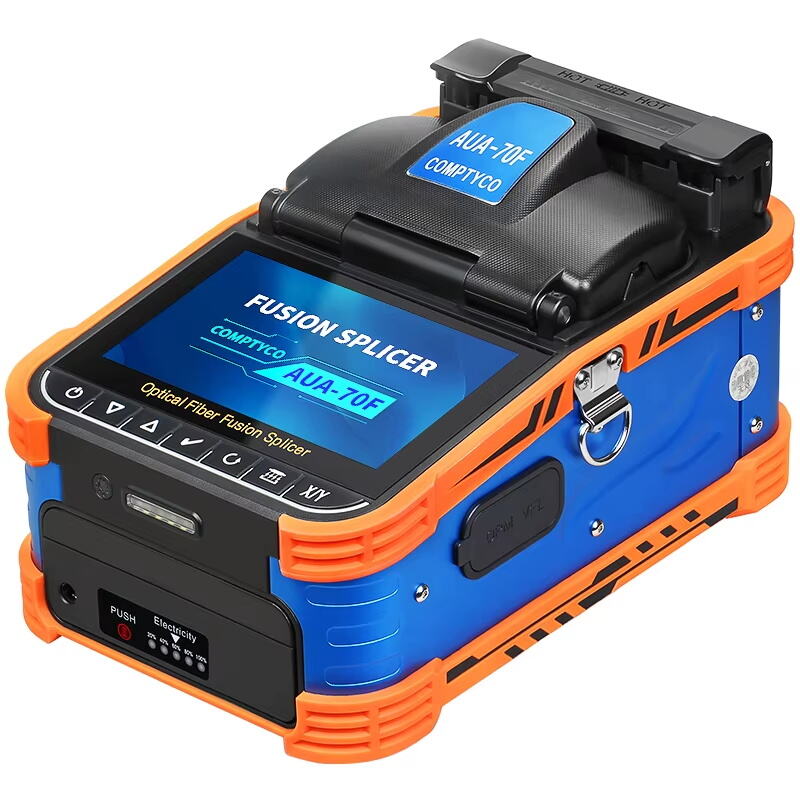Compreendendo Fusores de Fibra Óptica
Fusionadoras são aqueles equipamentos especiais que unem fibras ópticas, alinhando-as corretamente e fundindo-as com eletricidade. Ao construir ou reparar redes de fibra óptica, é muito importante que essa conexão seja feita com precisão, pois, se as fibras não forem bem alinhadas, toda a rede será afetada. Boas fusionadoras criam conexões tão firmes que há praticamente nenhuma perda de sinal, o que significa uma transferência de dados mais clara ao longo de grandes distâncias. Na verdade, existem vários tipos dessas fusionadoras. Algumas funcionam melhor para certos trabalhos dependendo de se precisam alinhar o centro exato (núcleo) da fibra ou a camada externa (revestimento). Os técnicos geralmente escolhem a ferramenta mais adequada para o serviço com base no tipo de fibra com a qual estão trabalhando e na precisão necessária para a conexão na instalação específica.
A fusão por emenda continua sendo importante para o trabalho com fibra óptica, pois mantém a perda de sinal no mínimo, obtendo ao mesmo tempo o melhor desempenho possível do sistema, o que sustenta aquelas transferências de dados rápidas das quais todos dependem atualmente. Esses emendadores utilizam métodos bastante sofisticados para alinhar e unir as fibras, tornando-os essenciais para manter as redes ópticas funcionando sem interrupções. Quando realizada corretamente, a emenda por fusão reduz a perda indesejada de luz e reflexos na junção das fibras, resultando em maior largura de banda e conexões mais confiáveis em geral. Por isso, as empresas de telecomunicações não podem prescindir de emendadores de boa qualidade, à medida que suas redes continuam crescendo e lidando com volumes cada vez maiores de tráfego anualmente.
Principais Características dos Fusion Splicers
Entender as principais características de emendadores de fusão é essencial para escolher a ferramenta certa para redes de fibra óptica. Essas características determinam a eficiência e a confiabilidade do processo de splicing em várias aplicações.
Tipo de empalhamento
Fusionadoras geralmente se enquadram em duas categorias principais: modelos para fibra única e versões para fibra tipo fita. O tipo de fibra única é amplamente utilizado porque é bastante versátil. Esses equipamentos trabalham com uma única fibra de cada vez, sendo ideais para trabalhos detalhados onde a precisão é fundamental, como na instalação de conexões de fibra em residências por meio de projetos FTTH. Por outro lado, as fusionadoras para fita são projetadas para operações em grande escala. Elas conseguem processar entre 6 e 12 fibras simultaneamente, o que reduz significativamente o tempo de trabalho. Engenheiros de rede adoram essas máquinas ao lidar com grandes projetos de infraestrutura que exigem centenas ou até milhares de conexões. A economia gerada é considerável nesses casos, especialmente quando empresas precisam implantar grandes quantidades de fibra em redes urbanas ou centros de dados.
Perda de Fusão
Reduzir a perda de emenda para níveis realmente baixos é muito importante para manter os sistemas de fibra óptica funcionando em seu melhor desempenho. Os modelos mais recentes de fusores disponíveis no mercado conseguem reduzir esses valores até cerca de 0,01 dB ou até melhor. Quando falamos de perdas tão pequenas, o que realmente observamos é um desempenho geral da rede superior e sinais de dados mais limpos em toda a linha. Tome como exemplo os fusores de alinhamento de núcleo. Esses dispositivos contam com tecnologia bastante avançada de alinhamento, que ajuda a reduzir aquelas perdas irritantes nas emendas. Por isso, os técnicos dependem fortemente deles para trabalhos em que o desempenho é essencial, especialmente em configurações como CATV ou na implantação de redes troncais, onde cada bit da intensidade do sinal importa.
Tempo de Fusão
Tempos rápidos de fusão são cada vez mais importantes para projetos que exigem instalações e reparos rápidos. Fusores modernos podem concluir uma fusão em menos de 30 segundos. Essa eficiência é crucial para reduzir o tempo de inatividade e acelerar os prazos dos projetos, especialmente em ambientes dinâmicos, como as telecomunicações e operações de manutenção de emergência.
Vida Útil do Eletrodo
A durabilidade dos eletrodos é muito importante ao escolher uma máquina de fusão. A maioria dos eletrodos suporta cerca de 2000 a 3000 fusões antes de precisarem ser substituídos. Quando os eletrodos duram mais, os técnicos não precisam substituí-los com tanta frequência, o que reduz os custos de manutenção e facilita o planejamento em grandes projetos. Uma máquina de qualidade com eletrodos duráveis realmente faz diferença na economia a longo prazo. Muitos engenheiros no campo descobrem que investir em eletrodos melhores desde o início compensa meses depois, quando não precisam parar constantemente o trabalho para substituições.
Display e Interface
Fusionadores que são fáceis de usar com telas claras fazem toda a diferença ao trabalhar no campo. Muitos modelos mais recentes vêm com telas sensíveis ao toque e menus simples, permitindo que os técnicos realizem tarefas sem dificuldades, mesmo em condições não ideais. O modo como essas ferramentas são projetadas reduz efetivamente o tempo gasto na fusão, ao mesmo tempo que minimiza erros causados por pressionar botões incorretos. Para quem instala redes de cabos, isso é muito importante, pois erros geram custos e atrasam projetos. Uma boa interface significa resultados melhores no geral.
Incorporar esses recursos-chave no seu processo de tomada de decisão ajudará a garantir que você selecione o fusor mais apropriado para suas necessidades específicas, melhorando o desempenho e a confiabilidade da sua rede de fibra óptica.
Considerações Adicionais Ao Escolher um Fusão Splicer
Ao escolher um fusor de fibra óptica, existem outras considerações além do preço que realmente afetam o desempenho ao longo do tempo. A duração da bateria é muito importante, especialmente se alguém precisar trabalhar no campo, longe de tomadas. Ter um fusor de boa qualidade que dure o dia inteiro significa menos interrupções durante os trabalhos de instalação. Para equipes que atuam em manutenção de dutos ou em melhorias de telecomunicações em áreas rurais, onde geradores podem ser escassos, isso faz toda a diferença entre concluir o trabalho corretamente ou ter que voltar outro dia por conta de o equipamento ter descarregado pela metade.
Proteger os equipamentos do ambiente também é muito importante. Faz todo o sentido utilizar equipamentos que resistam à poeira, à humidade e a extremos de temperatura, especialmente quando se deseja um uso de longo prazo. Observe os fusores com boas classificações IP disponíveis atualmente – eles são fabricados com durabilidade suficiente para suportar qualquer condição que a natureza apresentar, mantendo seu funcionamento adequado. Os técnicos de campo sabem disso muito bem, pois quando as ferramentas sobrevivem a condições adversas, elas duram mais e exigem menos reparos ao longo do tempo. Um fusor que continue funcionando sob chuva, neve ou calor intenso de desertos acaba economizando tempo e dinheiro a longo prazo para quem realiza instalações externas com regularidade.
A cobertura de garantia e o suporte do fabricante são muito importantes ao comprar fusores. Analisar o que diferentes empresas oferecem em termos de garantias e suporte técnico ajuda as empresas a tomarem decisões mais embasadas. Marcas de destaque geralmente oferecem boas opções de suporte juntamente com períodos de garantia mais longos, o que dá aos compradores certa segurança caso algo saia do planejado no futuro. Um bom serviço pós-venda também economiza dinheiro a longo prazo, já que os técnicos gastam menos tempo lidando com equipamentos quebrados e mais tempo realizando trabalhos efetivos. Quando as empresas consideram todos esses fatores, acabam selecionando fusores que realmente atendem às suas necessidades diárias, evitando complicações futuras.
Conclusão: Escolher o fusor certo aumenta a eficiência e a qualidade
Escolher o modelo correto de fusora faz toda a diferença quando se trata de eficiência no fluxo de trabalho e qualidade no trabalho com fibras que realmente apresente bom desempenho nas redes. Ao escolher uma dessas máquinas, as pessoas precisam saber quais recursos são mais importantes para suas necessidades específicas, considerando também fatores como a duração da bateria durante o trabalho no campo e se a unidade é capaz de suportar ambientes adversos sem apresentar falhas. O suporte do fabricante também não deve ser ignorado, pois um suporte técnico inadequado resulta em tempo desperdiçado solucionando problemas mais tarde. As empresas que se dedicam a analisar todos esses aspectos normalmente acabam com equipamentos de melhor desempenho, que economizam dinheiro a longo prazo, ao invés de apenas parecerem bons no papel.
Perguntas Frequentes
Qual é o uso principal de um fusor de fibras?
Um fusor de fibras é usado principalmente para unir duas fibras ópticas alinhando e fundindo-as, o que é essencial em redes de fibra óptica para transmissão eficiente de dados.
Quais são os tipos de fusores de fibras?
Há dois tipos principais: fusores de fibra única, que tratam uma fibra por vez, e fusores de fibra fita, que podem unir várias fibras simultaneamente.
Por que a perda de splicing é importante nos fusores de fibras ópticas?
A perda de splicing é crucial porque minimizá-la garante um desempenho óptico alto e uma transmissão de dados de qualidade em sistemas de fibra óptica.
Como a proteção ambiental afeta um fusor de fibras ópticas?
A proteção ambiental garante que o fusor de fibras ópticas possa resistir a condições adversas, aumentando sua vida útil e reduzindo as necessidades de manutenção.
Por que a duração da bateria é importante para fusores de fibras ópticas?
A duração da bateria é crítica, especialmente em locais remotos, pois permite operações contínuas sem recargas frequentes, aumentando a produtividade.







